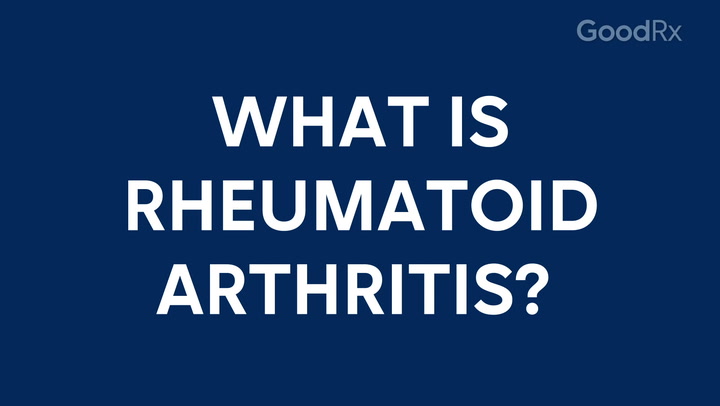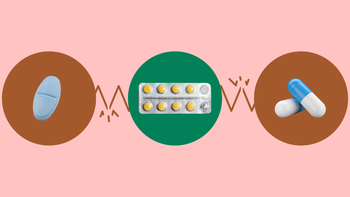
GoodRx Guide
Rheumatoid Arthritis: Your GoodRx Guide
Comprehensive information for you or a loved one — including treatment options and discounts on popular medications.What is rheumatoid arthritis (RA)?
Rheumatoid arthritis (RA) is a type of arthritis, or joint inflammation. The term “rheumatoid” refers to conditions that cause inflammation in the muscles, joints, and connective tissues. RA is the most common autoimmune joint disease, affecting up to 1.5 million Americans.
There are many types of arthritis, each with different symptoms and causes. The symptoms of RA, including joint pain, swelling, and stiffness, are caused by your body’s own immune system harming your joints. Since the immune system attacks your body instead of targeting viruses and bacteria, this makes RA an autoimmune disease.
Over time, the RA-related inflammation can lead to joint damage and destruction. It can also affect other parts of your body, including your heart, lungs, and eyes.
RA may also increase your risk of other conditions, including:
RA is a chronic condition that can affect mobility, independence, and quality of life. There’s no cure. But with treatment, it’s possible to control your symptoms, prevent or slow joint damage, and lead an active life.
Symptoms of rheumatoid arthritis
The autoimmune inflammation in rheumatoid arthritis (RA) causes symptoms such as:
Pain, swelling, and stiffness in your joints
Fatigue
Fever
Loss of appetite
Dry eyes and mouth
Small, firm bumps under your skin, called rheumatoid nodules, usually near your elbows or hand joints
Usually, RA affects the joints on both sides of your body equally. But sometimes, early in the disease, a single joint may be affected. RA usually starts in the small joints of your hands and feet but can affect any joint. Joint stiffness in the morning is common.
Symptoms can come and go from day to day. When symptoms worsen, it’s called a “flare.”
Long-standing or untreated RA can make it difficult to work and enjoy daily activities. It may also lead to:
Joint damage
Heart and lung disease
Infections
What causes rheumatoid arthritis?
The exact cause of autoimmune diseases like rheumatoid arthritis (RA) is unclear. Many complex factors are involved, including genetics and environmental exposures.
Studies have estimated that RA has a heritability of 60%. This means that genes play a large role in causing the disease. But they aren’t the only cause. People with genes linked to RA may be more likely to develop it — or to have worse symptoms — when exposed to the same environmental risk factors as those without these genes.
This combination triggers an immune cascade that results in many different inflammatory cells and proteins in and around your joints. Over time, the ongoing inflammation damages cartilage and ends of the bones, causing permanent joint damage.

Risk factors for RA
Although rheumatoid arthritis (RA) can happen to anyone — anywhere and at any age — there are some well-established risk factors for developing the condition:
Sex at birth: About three out of every four people with RA are women.
Age: Symptoms of RA usually start between ages 30 and 60, and the risk increases with age. But RA can develop at any age, even in childhood.
Family history: Having a family member with RA increases your risk of getting it.
Where you’re from: You’re more likely to develop RA if you live in Australasia, Western Europe, or North America.
Smoking cigarettes: This is the strongest modifiable risk factor for developing RA. The more you smoke, the higher your risk.
Inhaled exposure: Long-term exposure to silica (mining), pesticides, and air pollution may also increase your risk of RA.
Research suggests that low levels of vitamin D and omega-3 fatty acids may be linked to a higher risk of RA. But it’s unclear if supplementation reduces the risk of developing RA.
How is rheumatoid arthritis diagnosed?
The first step in diagnosing rheumatoid arthritis (RA) is seeing your primary care provider. If you or your primary care provider think your joint pain may be due to RA, the next step may be to see a specialist known as a rheumatologist.
The rheumatologist will ask questions about your:
Symptoms
Medical history
Family history
Current medications
They’ll also perform a physical exam and may order lab work and imaging tests.
Common lab tests for RA are:
Rheumatoid factor (RF): An autoantibody found in 70% to 80% of people with RA
Anti-cyclic citrullinated peptide antibody (anti-CCP): An autoantibody that’s commonly found early in RA
Complete blood count (CBC): A routine blood test that can reveal anemia, a common condition linked to RA
Erythrocyte sedimentation rate (ESR): A test that can measure inflammation levels
C-reactive protein (CRP): Another test that indicates inflammation in your body
Common imaging tests include:
X-rays: This type of imaging can show joint damage. Sometimes, X-rays may appear normal in early RA before joint damage is severe.
MRI or ultrasound: These can show inflammation that an X-ray might not be able to detect yet. These can be useful if your X-rays are normal, but your symptoms strongly suggest you have RA. So, they can help with early diagnosis.
Rheumatoid arthritis treatments
Once rheumatoid (RA) is diagnosed, it’s important to start treatment right away. While there’s no cure, safe and effective treatments can help control symptoms and reduce your risk of long-term complications, like joint damage and disability.
Treatment can include:
Medications
Physical therapy
Lifestyle changes
Surgery
The goal of treatment is to achieve remission, which means eliminating the inflammation causing your symptoms. This will improve pain and swelling in affected joints and prevent other joints from being affected. This isn’t the same as a cure, as the inflammation can come back if you stop treatment. It’s also important to stay active and maintain motion in your joints.
Even with treatment, not everyone is able to achieve remission. In that case, the goal is to reduce the inflammation as much as possible to increase pain-free days. Slowing down the disease can help prevent irreversible joint damage over time.
Sometimes, surgery is needed for joints that are severely damaged. However, with improvements in medications, the need for joint replacement surgery has decreased in people with RA in recent years.
Medications for RA
The most effective treatments for rheumatoid arthritis (RA) require a diagnosis and a prescription. They include:
Anti-inflammatory medications: Examples are nonsteroidal anti-inflammatory drugs (NSAIDs) and steroids.
Disease-modifying antirheumatic drugs (DMARDS): DMARDs treat and prevent symptoms by decreasing inflammation and slowing disease progression.
Biologic response modifiers: These block signals within your immune system. They also slow disease progression.
The first line of treatment is usually anti-inflammatory medications to quickly get your symptoms under control. They’re commonly prescribed at low doses for a short time (less than 3 months). Examples include:
Diclofenac (also available as a topical cream)
Once diagnosed with RA, your rheumatologist is likely to recommend that you start a DMARD to help slow the disease. You may start with one DMARD and then need to add another one. Examples include:
If your symptoms don’t get better with DMARDs, the next step is to start a biologic medication. Examples include:
Adalimumab (Humira)
Etanercept (Enbrel)
Tocilizumab (Actemra)
You may need to try several different medications or combinations to find what works best for you. The best combination of medications can also change with time, meaning that some medications might work for a while and then stop working. It’s common to have to make changes during treatment.
Each of these medications can have different side effects, some of which can be serious. Most people will need regular lab work to check that the medications aren’t causing problems.
Living with RA
Sometimes, rheumatoid arthritis (RA) flares can make usual activities difficult, and you may need a short course of steroids or pain medication. That said, most people with well-controlled RA are able to lead active lives.
Exercise is safe for people with RA, and experts recommend it. Activities that can help include:
Low-impact exercises such as walking and swimming can minimize joint stress
Flexibility exercises can help reduce joint stiffness
Muscle-strengthening exercises can prevent muscle loss
Balance exercises can help prevent falls
If you’re new to exercise, be sure to speak to a healthcare professional before getting started.
There are also other ways to help ease joint pain, including:
Hot and cold compresses
Warm baths
Massage therapy
Acupuncture or acupressure
Stress and poor sleep can make joint pain and inflammation worse. Some strategies that can help with pain management and fatigue include:
Meditation, mindfulness, and deep breathing
Emotional support and cognitive behavioral therapy (CBT)
Plenty of rest (to avoiding overusing your joints)
Frequently asked questions
There are four stages of RA, based on how it has affected your joints. Stage 1 is when X-rays don’t show joint damage, while Stage 2 is when X-rays start to show some joint damage. In stage 3, there’s more serious cartilage and bone damage with deformity of your joint. Stage 4 is when your bones have begun to fuse together, causing end-stage disease.
Without treatment, RA can lead to irreversible joint damage, which can cause major disability. Long-term inflammation in your body that’s untreated can also increase your risk of heart attack or stroke.
On the other hand, RA medications affect your immune system, which helps protect against infection and some cancers. Using these medications for a long time can increase your risk of infections and other side effects.
Some studies have shown that women with RA may have a hard time getting pregnant, but pregnancy is still safe. In fact, many experience improved symptoms during pregnancy, though symptoms can return or worsen after delivery. Importantly, not all RA medications are safe during pregnancy. So, it’s important to discuss pregnancy plans with your rheumatologist ahead of time.
Common triggers of an RA flare include stress, lack of or poor sleep, and illness. RA symptoms can also flare because of overexertion or a diet high in sugar and processed foods.
Yes, many types of arthritis — including RA — may qualify for disability benefits through the Social Security Administration. It’s a good idea to become familiar with the types of disability programs and the application process. A healthcare professional can help you with documentation.
References
American College of Rheumatology. (n.d.). Rheumatologist.
Arthritis Foundation. (n.d.). Understanding drug side effects and risks.
Arthritis Foundation. (2021). Rheumatoid arthritis: Causes, symptoms, treatments and more.
Axtell, B. (n.d.). Your RA is in remission! Now what? Arthritis Foundation.
Brouwer, J., et al. (2014). Fertility in women with rheumatoid arthritis: Influence of disease activity and medication. Annals of the Rheumatic Diseases.
Chauhan, K., et al. (2023). Rheumatoid arthritis. StatPearls.
Conley, B., et al. (2023). What are the core recommendations for rheumatoid arthritis care? Systematic review of clinical practice guidelines. Clinical Rheumatology.
Cross, M., et al. (2014). The global burden of rheumatoid arthritis: Estimates from the global burden of disease 2010 study. Annals of the Rheumatic Diseases.
Deane, K. D., et al. (2018). Genetic and environmental risk factors for rheumatoid arthritis. Best Practice & Research Clinical Rheumatology.
England, B. R., et al. (2023). 2022 American College of Rheumatology Guideline for exercise, rehabilitation, diet, and additional integrative interventions for rheumatoid arthritis. Arthritis Care and Research.
Exercise is Medicine. (2021). Being active when you have rheumatoid arthritis. American College of Sports Medicine.
Fraenkel, L., et al. (2021). 2021 American College of Rheumatology guideline for the treatment of rheumatoid arthritis. Arthritis Care and Research.
Guo, Q., et al. (2018). Rheumatoid arthritis: pathological mechanisms and modern pharmacologic therapies. Bone Research.
Harty, L., et al. (2014). Profound reduction in hospital admissions and musculoskeletal surgical procedures for rheumatoid arthritis with concurrent changes in clinical practice (1995-2010). Rheumatology.
Imanuel, C. A., et al. (2023). Associations between rheumatoid arthritis and various comorbid conditions in Germany—a retrospective cohort study. Journal of Clinical Medicine.
Maisha, J. A., et al. (2023). Modifiable risk factors linked to the development of rheumatoid arthritis: evidence, immunological mechanisms and prevention. Frontiers in Immunology.
MedlinePlus. (n.d.). What is heritability?
National Cancer Institute. (n.d.). Rheumatism. National Institute of Health.
National Institute of Arthritis and Musculoskeletal and Skin Diseases. (2022). Rheumatoid arthritis. National Institute of Health.
National Institute of Arthritis and Musculoskeletal and Skin Diseases. (2022). Rheumatoid arthritis: Diagnosis, treatment, and steps to take. National Institute of Health.
National Health Service. (2023). Complications: rheumatoid arthritis.
Shah, B. (2023). Rheumatoid arthritis. American College of Rheumatology.
Wilson, D. (2006). Rheumatoid factors in patients with rheumatoid arthritis. Canadian Family Physician.






























